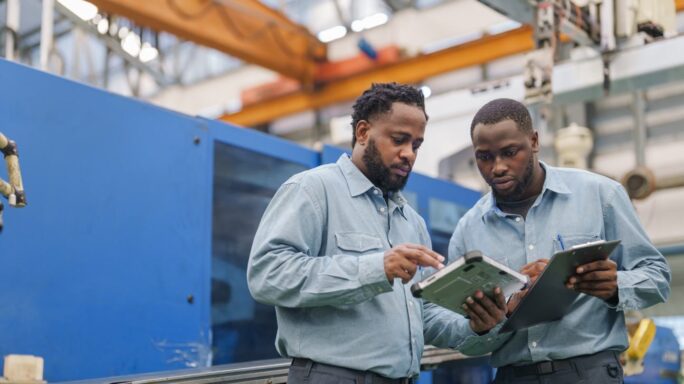What is inventory?
Explore the essentials of inventory - its definition, valuation methods, types, tracking systems, and effective management strategies for businesses.

Imagine your business operating with such precision that you always have exactly what you need when you need it—no more overstock eating up valuable space and no more shortages leading to missed opportunities.
This is the power of inventory management. It’s not just about keeping the shelves stocked but crafting a finely tuned system that seamlessly balances supply with demand.
Effective inventory management is pivotal in slashing costs and supercharging operational efficiency, propelling your business toward peak financial health and operational excellence.
It’s the engine behind the scenes, ensuring every gear in your business machine runs smoothly, transforming potential chaos into coordinated harmony.
Here’s what we’ll cover
What are the different inventory types?
Understanding inventory models
An example of inventory tracking in action
What is best practice for inventory control?
How do you benefit from inventory analysis?
Automate your small business accounting
Easy to setup. Easy to use.
Save time, improve cash flow, and get paid faster with Sage Accounting.

What is inventory?
Inventory encompasses all items a business holds for resale, production, or service delivery. Managing these items efficiently is crucial for continuous operations and high customer satisfaction.
Action points
Encourage timely production and fulfillment: boosts customer satisfaction and encourages repeat business.
Optimize stock levels: prevents overstocking and stockouts, enhancing profitability.
What are the different inventory types?
Inventory can be classified into several types based on their stage of completion:
Raw materials
These are the fundamental components used in producing finished goods.
Think of a bakery. The flour, sugar, and yeast stored in the back are essential starting points for all the bakery’s products.
These raw materials are the foundation from which all products are made.
Work-In-Progress (WIP)
This includes goods currently being produced but not yet complete.
In the context of a winery, WIP could be the wine currently fermenting in vats. It’s not ready to be sold yet but is in the process of becoming a finished product.
Finished goods
These products are entirely manufactured and ready for sale to customers.
For an electronics retailer, finished goods refer to items like smartphones and laptops prepared for sale to consumers.
Maintenance, Repair, and Operations (MRO) supplies
MRO supplies are essential for supporting production but are not sold as part of the finished products.
Consider a manufacturing plant that requires lubricants for machinery. These supplies are crucial for maintenance and operations but are not part of the products sold.
Other examples include cleaning supplies, factory equipment, or office supplies. These are recorded as expenses rather than assets.
Action Points
Recognize different types of inventories so you can apply specific management strategies to prevent overstocking and understocking.
Master the various inventory types—from raw materials to finished goods—so your business can adapt quickly to changes in demand without incurring unnecessary costs.
Create strategic flexibility to maintain a lean operation and maximize the return on investment in inventory, contributing directly to the bottom line.
Understanding inventory models
Inventory models are mathematical formulas designed to optimize managing inventory levels within a business. They help forecast demand, set reorder points, and minimize costs associated with holding too much or too little inventory.
Here are two of the most widely used inventory models: the Economic Order Quantity (EOQ) and Just-in-Time (JIT) systems.
Economic Order Quantity (EOQ):
EOQ is a formula that determines the ideal order quantity you should purchase for your inventory.
The goal is to minimize the costs of holding stock, ordering, and shortages.
This model is best suited if your business experiences consistent product demand. It calculates the optimal purchase quantity by balancing the cost of ordering and the cost of holding inventory, minimizing the total inventory cost.
Example:
A restaurant could use EOQ to manage its inventory of non-perishable supplies like napkins and cleaning materials, ensuring that it orders the optimal amount that minimizes storage space and order frequency.
Just-In-Time (JIT):
JIT is an inventory strategy that aligns raw-material orders from suppliers directly with production schedules.
It increases efficiency and decreases waste by receiving goods only as needed in production, reducing inventory costs.
This method requires accurate sales forecasting and dependable suppliers to avoid stockouts.
Example:
An auto manufacturer might implement JIT to manage the supply of parts needed for assembly lines, ordering them to arrive just as they are ready to be used, minimizing warehouse space, and reducing inventory holding costs.
Action points
Choose a suitable inventory model to improve inventory and reduce associated costs.
The EOQ model helps you reduce the total cost of inventory—such as holding costs, order costs, and shortage costs—by calculating the most economical quantity to order. This translates into lower operational costs and more capital available for investment in other areas.
JIT reduces waste and increases efficiency by aligning inventory acquisition directly with production schedules, which can significantly enhance your profitability through reduced storage and holding expense.
Work smarter with business management software
Integrate your business processes into one platform. Make informed decisions based on real-time data with complete visibility over your operations, inventory, and finances.

What is inventory control?
Inventory control involves managing inventory to maximize your business revenue without interrupting production.
It includes aspects such as setting reorder points, maintaining stock levels, and deciding when and how much to reorder.
Why is inventory control important?
Effective inventory control ensures operational efficiency by helping you avoid overstocking and understocking.
It helps you promptly meet customer demands without tying up too much capital in inventory, enhancing cash flow and reducing storage costs.
Effective inventory control helps balance supply and demand and ensures you can respond swiftly to customer needs without excessive stock investment.
This efficiency leads to higher customer satisfaction rates due to reliable product availability and contributes to healthier cash flow management, which is crucial for operational and financial stability.
What is best practice for inventory control?
Inventory tracking
Efficient inventory tracking is crucial for determining when to reorder stock to prevent stockouts—which can lead to lost sales and harm your brand’s reputation—and overstocking, which ties up capital and increases storage costs.
Maintaining optimal stock levels ensures smoother operations, better cash flow management, and improved customer satisfaction.
Action points
Implement robust inventory control practices to enhance customer satisfaction by ensuring product availability while optimizing cash flow and minimizing holding costs.
Consider integrating demand forecasting, which uses historical sales data to predict future trends and proactively adjust inventory levels.
Create synergy between tracking and forecasting, securing profitability and bolstering your business’s ability to meet market demand efficiently.
Manual versus automated inventory tracking
Inventory tracking can be as simple as maintaining a spreadsheet with product details and quantities or as sophisticated as using dedicated inventory management software.
Manual tracking
This is a traditional method of manually counting your inventory and updating a record, usually a spreadsheet.
While this method might work for a small business with limited items, it can be time-consuming and prone to human error, especially as the company grows and inventory expands.
Automated tracking
This involves using inventory management software to update stock levels as products are bought and sold automatically.
With an automated tracking system, you could get real-time inventory updates, track products across multiple locations, generate sales forecasts, and send reorder alerts when stock levels are low.
What you should do
- Look for tech that integrates with point-of-sale systems and offers insights into inventory trends.
- Prepare upfront investment for the technology, as increasing efficiency and accuracy could deliver significant long-term benefits.
Barcode scanning and RFID systems
Technological advancements have significantly refined inventory management practices.
Barcode scanning and Radio Frequency Identification (RFID) systems are at the forefront, enhancing accuracy with real-time data collection and automation.
- Barcode scanning: this method assigns a unique identifier to each item, supporting quick data access and efficient stock management.
- Radio Frequency Identification (RFID): RFID tags read through radio waves and continuously monitor multiple items simultaneously without requiring direct line-of-sight scanning.
These technologies have substantially evolved from traditional manual entries and basic spreadsheets, providing dynamic control in streamlining operations.
Action points
Implement comprehensive inventory tracking to maintain optimal stock levels and support business growth.
Select a tracking method that enhances efficiency and aligns with your operational goals.
Focus on informed decision-making using accurate data from tracking and demand forecasting.
Manage inventory proactively to meet demand without overextending resources, minimizing the risk of stockouts and excess inventory.
Free up capital for strategic investments by avoiding unnecessary stock accumulation.
Automate your small business accounting
Easy to setup. Easy to use.
Save time, improve cash flow, and get paid faster with Sage Accounting.

An example of inventory tracking in action
Consider “Brewed Delights,” a fictional coffee shop in downtown Boston.
Initially, they used a manual system to manage their coffee beans, snacks, and merchandise inventory.
- As the shop grew, this method became inefficient, leading to frequent stockouts of popular items and overstocks of less popular products, negatively affecting customer satisfaction and profitability.
- To address these issues, Brewed Delights switched to an automated inventory tracking system. Each product received a unique barcode, enabling automated tracking at the point of sale.
- The system automatically updates inventory counts and alerts the staff when stock levels of items, like their signature house blend, are low. This feature allowed timely reordering, preventing stockouts.
- Additionally, the system offers insights into sales trends, helping the shop identify best-sellers and underperformers. This allows the business to optimize inventory levels and reduce excess stock.
The initial investment in the automated system paid off by enhancing inventory accuracy, minimizing losses, and improving customer satisfaction and profitability.
This example shows the transformative impact that effective inventory tracking can have on a business.
What is inventory auditing?
Regular inventory audits are essential for maintaining accurate records and identifying discrepancies due to theft, damage, or errors.
While comprehensive audits can be time-consuming, you might use cycle counting to efficiently count a subset of inventory on specific days without disrupting daily operations.
What is inventory turnover?
Inventory turnover is a ratio that measures the number of times inventory is sold or consumed in a specific period.
A higher turnover indicates efficient inventory management and sales performance, whereas a lower turnover might suggest overstocking or issues with the product.
What is inventory analysis?
Inventory analysis involves examining your inventory to identify trends, optimize stock levels, and improve efficiency.
Techniques such as ABC analysis categorize inventory based on importance and sales contribution, helping you prioritize your focus and resources.
ABC analysis is a method of categorizing inventory into 3 classes:
Category A: high-value items with a low frequency of sales require tight control and detailed tracking.
Category B: items of moderate value and sales frequency require moderately strict controls.
Category C: low-value items with high sales frequency; these are bulk items that are less closely monitored but crucial for volume.
How do you benefit from inventory analysis?
Your business will gain from inventory analysis through enhanced understanding of product performance, better customer satisfaction through improved product availability, and reduced costs by minimizing excess inventory.
After using a technique like ABC analysis, you can apply the most appropriate valuation method to accurately assess and manage your financial reporting and tax obligations.
Inventory valuation methods
Inventory valuation is essential in accounting. It impacts a business’s financial statements and tax liabilities.
It also affects calculating the Cost of Goods Sold (COGS) and gross profit, which is crucial for assessing your business performance.
First-In, First-Out (FIFO): the oldest inventory items are sold first and are suitable for perishable goods to prevent spoilage. This method typically results in lower COGS and higher profits, potentially increasing tax liabilities during inflationary periods.
Last-In, First-Out (LIFO): the newest inventory is sold first, reversing the order of FIFO. This can reduce inflation taxes by increasing COGS and lowering profits. Note: LIFO is not accepted under all accounting standards, so its applicability may vary by region.
Weighted Average Cost (WAC): calculates an average cost for all inventory items after each purchase, dividing total cost by total units available. This method smooths out price variations and simplifies accounting in complex inventory systems.
Specific identification: this method uses high-value items, like jewelry or cars, with easily identifiable characteristics. The cost of each item is tracked individually and used directly in COGS calculations.
Action points
- Carefully select the appropriate inventory valuation method to optimize your business’s financial outcomes. The right choice impacts your profit, taxable income, and inventory management.
- Each method offers benefits and challenges, depending on your inventory type, business model, and regional accounting standards.
- Assess your business needs and seek advice from an accountant to ensure a well-informed decision.
Final thoughts
Master inventory management for increased operational efficiency, profitability, and customer satisfaction.
Bookmark this article to help you understand different inventory types, appropriate models, and robust control systems so that you can effectively manage current and future business challenges and capitalize on opportunities.
Editor’s note: This article was originally published in June 2023 and has been updated for relevance.






Ask the author a question or share your advice